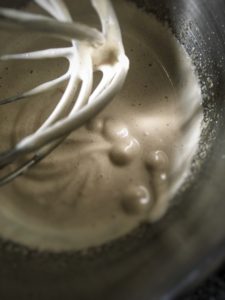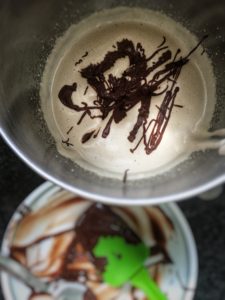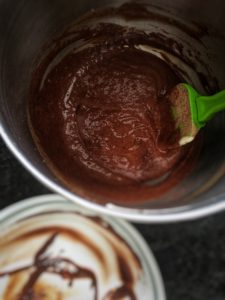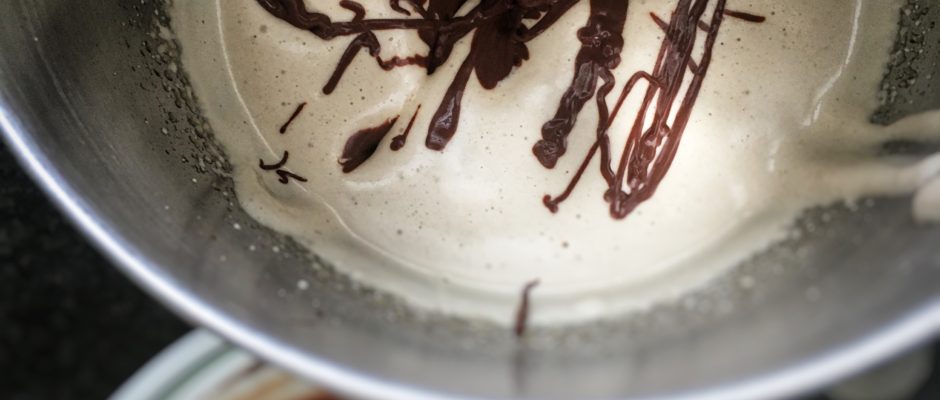Simplicity Coimbatore , Aquafaba
After thinking about it off and on for a few years, I finally ended up making an Aquafaba chocolate mousse. When I came across this recipe using just three ingredients ; chickpea water (kabuli channa) , sugar and melted chocolate coverture ,I was truly amazed. I had no idea then that it was called Aquafaba. It just seemed to me that this was food science at its best .To be able to whip the leftover liquid from cooking channa and blend it with chocolate to make a mousse, seemed incredible!

Recipe for Aquafaba Chocolate Mousse
One reason that I never ventured into making a traditional chocolate mousse was because of the raw egg white used.Raw egg white whipped to a stiff consistency is used to add airiness to different desserts.
There are so many reasons why I am wary of using un-cooked egg white ;the fear of salmonella,the not so nice egg-y smell and somehow ‘raw’ doesn’t sit so well in my head. The only raw food I am okay with consuming has to be plant based !
Anyway getting back to the Aquafaba, as the name suggests ,it does contain water. Aquafaba (Aqua -water; faba- bean) ,for those unfamiliar with the word, is water in which legumes have been cooked. While this does apply to all legumes, it’s the white channa water which is most popular when it comes to using the Aquafaba for making other dishes.
The inherent starch in the legume leaches out into the water when cooking ,making it viscous and slightly gelatinous ,similar to that of the egg white.Now please don’t ask me who discovered this…that information has been hard to source . However, this is great news for the vegetarians and vegans. The process may sound simple but it does need a bit of work to get the Aquafaba working ,especially if you want to make a chocolate mousse.

For years vegetarians or vegans who love baking have looked for various forms of egg substitutes to get that light airy cake .Ingredients like curd, egg powder substitute or other synthetic agents have never been fully accurate in mimicking eggs in desserts.
Instructions for making Aquafaba are available on so many online sites.Vegan websites, recipe developers, Wikipedia , you tube videos etc etc , there are several variations to making the kind of Aquafaba one needs.
In countries where buying tinned food is popular the recipes from the people who live there recommend using the water from canned chickpeas. Because the liquid in the tin is much more concentrated the chances of getting a well whipped Aquafaba is apparently far easier than using water from freshly cooked chickpeas.
Using tinned chickpeas was definitely not an option for me. So our Aquafaba experiment began by carefully saving the water after cooking the channa. We realised soon enough that it’s not as simple as whipping the water in which the channa was cooked. After whipping for over half an hour all we had was a well aerated runny liquid with a lot of bubbles. That was clearly not going to make any mousse!
So a little more research had to happen to perfect the method. Apparently the quantity of water leftover after cooking the chickpeas matters a lot. And here we thought the more water we added ,the greater the quantity of Aquafaba ! Wrong !

The Aquafaba has to be as concentrated as possible. After the channa is cooked, the liquid remaining should only amount to 3/4th of a cup or half a cup.If not ,it has to be reduced down by boiling. The liquid then needs to be cooled completely before whipping.
Some theories suggest refrigerating the liquid for a few hours so that it becomes slightly gelatinous. We did that the third time. All for that perfect,eggless chocolate mousse.
The second time around the water was boiled down to get a concentrated Aquafaba. It then whipped up into a thick emulsion when beaten with sugar (natural palm sugar) using a stand mixer. A few minutes later it turned into soft peaks. The evening light was just starting to go to dusk when we managed to take a few pictures. The melted dark chocolate from the cacao farm at Pollachi was waiting to be folded into the smooth Aquafaba. Finally it was spooned into curved bottomed glass dessert cups, to set.
Another recipe also suggests adding some cream of tartar while whipping. Usually this is available at our supermarkets but since we didn’t have any,we went ahead without it. The refrigerated Aquafaba did get thicker much faster when whipping and formed small stiff peaks ,not as stiff as the egg whites but I guess that it will become better with practice. It’s also a good idea to cool it in ice cube trays for it to get that viscosity faster, in the freezer.
An hour later the dark chocolate mousse had set beautifully. It looked smooth and when lifted with a spoon, the airiness was visble.It had a wonderful mouth feel and had the perfect unctuousness of rich ,smooth chocolate. The family said that it reminded them of a delicious chocolate mousse they had tasted previously at a vintage hotel in Germany. Compliments like that are what push me to give recipes like this a try!

Nutrition wise the Aquafaba has only 1/10 th of the protein content present in egg whites. The Aquafaba is also known to create flatulence. People who suffer from gastric issues must consume it in moderation.
The Aquafaba can be used to make cakes, french toast , puddings etc as a substitute for eggs. It doesn’t have to be whipped each time either. Just refrigerate the thick liquid and pour into ice cube trays to use when needed.
While I do use eggs for baking ,the Aquafaba is a super convenient option when the recipe calls for raw eggs. The next time we’re cooking channa, it will be to make much more than just a savoury dish .


No comments yet.